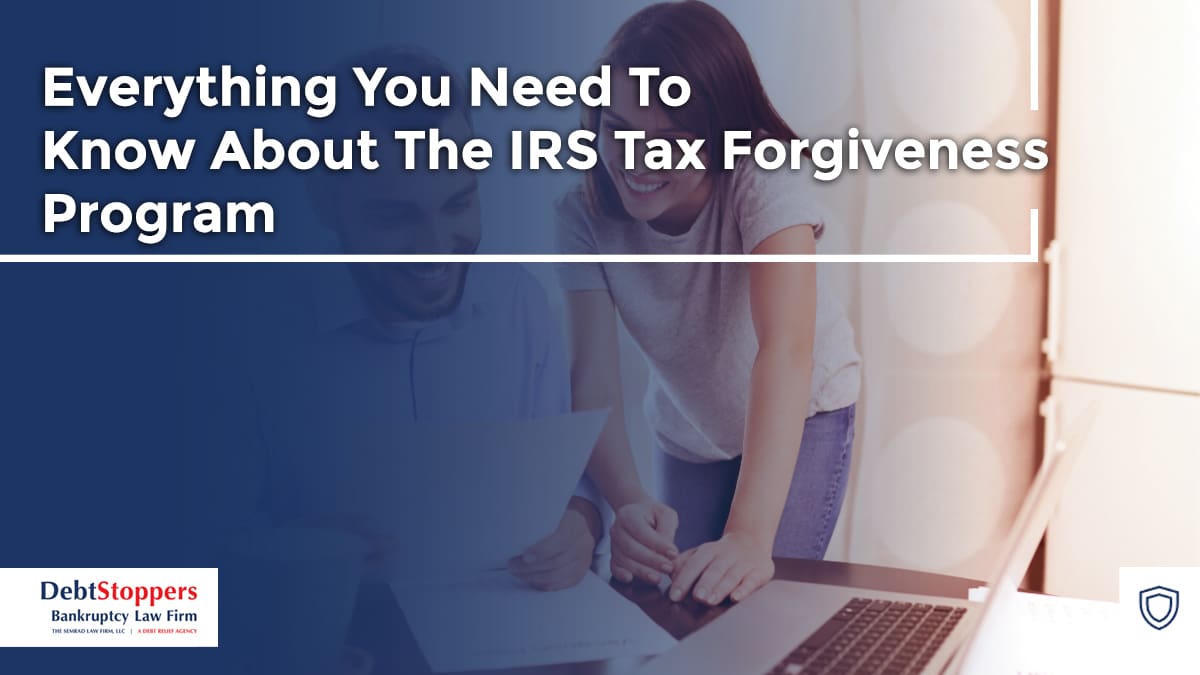Updated on 23 August 2025
Everything You Need To Know About The IRS Tax Forgiveness Program

Owing back taxes to the IRS can be overwhelming, in part because interest and penalties accumulate rapidly; what starts as a manageable balance quickly grows into a serious financial burden. For most people, paying the full amount of back taxes simply isn’t feasible.
Fortunately, the IRS provides several tax forgiveness programs aimed at helping taxpayers resolve their debt and avoid harsh collection actions, such as wage garnishments, bank levies, or property liens. Whether you are dealing with a short-term setback or ongoing financial hardship, understanding how these programs work and whether you qualify can be the first step toward finding relief.
What is the IRS tax relief program?
The IRS tax relief program, also referred to as IRS tax forgiveness, includes a variety of initiatives that allow taxpayers to settle, reduce, or otherwise better manage their tax debt.
One of the best-known forms of tax relief is called an Offer in Compromise (OIC), which allows eligible taxpayers to settle their tax debt for less than the full amount they owe.
The IRS may also provide relief through installment agreements, penalty abatement, or Currently Not Collectible (CNC) status, where the IRS temporarily stops collection efforts due to financial hardship. These programs are designed to offer relief based on your ability to pay, not just what you owe.
For people who have lost their jobs, experienced a medical emergency, or other financial hardship, IRS tax relief can help them regain control of their finances and work toward resolving their tax debt without fear of losing their assets.
Struggling with IRS Tax Debt?
You don’t have to face the IRS alone. Explore tax relief options like Offers in Compromise and get legal help today.
Free Tax Relief Consultation

Who qualifies for the IRS forgiveness program?
Eligibility for the IRS tax forgiveness program depends on several factors, including your income, expenses, assets, and overall financial situation. The IRS assesses whether you can reasonably pay your tax debt in full, either as a lump sum or through a payment plan. If not, you may qualify for one of their relief programs.
To be considered for an Offer in Compromise, you generally must be current with all tax filing and have received a bill for at least one tax debt. You must also be able to demonstrate that paying the full amount would create a financial hardship and not currently in an open bankruptcy proceeding.
If you do not qualify for a settlement, you might still be eligible for a partial payment installment plan or penalty relief. The IRS uses a strict formula that considers your monthly income and necessary living expenses when determining eligibility.
It is also important to understand that tax forgiveness isn’t guaranteed. Applications are closely reviewed by the IRS, and documentation is critical, which is why working with an experienced attorney can significantly improve your chances of success.

How do you qualify for tax forgiveness?
If you are unsure if you qualify, it’s wise to consult with an experienced tax attorney or other tax professional who can help ensure you understand what program is best for you.
What is the Tax Forgiveness Act and does it apply to you?
From time to time, Congress considers legislation that promises tax relief or forgiveness; however, there is not one piece of federal legislation called the Tax Forgiveness Act.
In 2024, the House of Representatives passed a type of Tax Forgiveness Act called the Tax Relief for American Families and Workers Act of 2024; however, the bill was not passed by the Senate and did not become law.
Since 2011, the IRS has offered a program called the Fresh Start Initiative, which can help taxpayers reduce their tax debt through the Offer in Compromise, penalty abatement, tax lien relief, and installment agreements. These programs have been routinely expanded since they was first introduced.
Each IRS program has specific and unique eligibility requirements. However, in general, you cannot owe more than $50,000; you must demonstrate to the IRS that you have financial hardship, and paying your full tax debt would create an undue financial burden on you or your family. Additionally, to be eligible, you cannot have missing tax returns and must have a good track record of payments to the IRS.
Sometimes people use the term tax forgiveness when referring to various IRS programs that can help taxpayers who cannot pay their full tax debt. It’s important to remember that getting your full tax liability forgiven is extremely uncommon but can sometimes be achieved through the Offer in Compromise.
How to apply to the IRS debt forgiveness program?
Applying to the IRS tax forgiveness program can be a complex and tedious process. The application requires detailed financial disclosures, supporting documents, and a persuasive case that paying the full amount would create a significant financial hardship.
Application
To apply for an Offer in Compromise, you will be required to complete IRS Form 656 and Form 433-A (OIC) for individuals or Form 433-B (OIC) for businesses. You will be required to list all sources of income, monthly living expenses, asset values, and outstanding debts on these forms.
The IRS uses the information you provide on your application to determine your reasonable collection potential (RCP), which is essentially how much the IRS believes they could collect from you through standard collection efforts.
Submitting an accurate application is critical to your success. Incomplete or inconsistent information can result in delays or even denial. Working with a tax attorney can ensure your application is properly prepared and your case is persuasive.
Get Back on Track with Tax Relief
Our attorneys have helped thousands reduce or eliminate tax debt. Find out if you qualify for IRS forgiveness today.
Start with a Free Case Review

Costs
Applying for the IRS forgiveness program is not free. As of 2025, the IRS charges a $205 application fee for an Offer in Compromise. In most cases, you must also make an initial payment when submitting your application. The payment amount varies depending on whether you choose a lump sum or a periodic payment plan. According to IRS guidelines, the application fee and initial payment can be waived if you qualify as low-income.
It is important to understand that although there is a cost to apply, the potential savings can be substantial if your offer is accepted.
How does tax forgiveness program work for retirees and seniors?
Congress recently passed legislation that will provide additional tax relief for seniors starting in 2026 through 2028. New relief includes an additional $6,000 senior deduction that is phased out gradually based on a filer’s modified adjusted gross income.
To help seniors reduce their overall tax bill, there are a number of credits and deductions specifically created for seniors age 65 and older. First, the standard deduction for seniors is automatically higher and seniors are also eligible for an additional tax credit based on their adjusted gross income, tax filing status, and non-taxable income. Additionally, seniors may be eligible for the Earned Income Tax Credit (EITC) if they work part-time or earn other income.
Some states and local jurisdictions provide specific property tax programs for seniors. However, not all states or locations offer these programs, and they are subject to change.
If a senior owes taxes that they cannot pay, they are also eligible to seek an Offer in Compromise or Currently Not Collectable status, which is not technically tax forgiveness, but at least temporarily stops IRS enforcement measures.
Pros and cons of the IRS tax forgiveness program
If you cannot pay your tax debt, utilizing one of the IRS tax relief programs may provide you with a lifeline to settle your debt for less or pay down your debt over time. The pros of tax relief programs are that people who qualify can save thousands of dollars and ultimately get out from under their IRS debt.
The cons of the programs are their complexity. The IRS programs are complex and require a significant amount documentation. Many people find the process overwhelming or make mistakes that delay or deny tax relief
If you are considering applying for one of the IRS tax relief options, it’s wise to consult with a qualified attorney or tax professional who can help you understand your options and make a compelling case to the IRS.

How can DebtStoppers help you with IRS debt forgiveness?
At DebtStoppers, we understand how stressful it is to have IRS tax debt. The letters, phone calls, and threats of legal action can take a toll on your life and mental health.
Our experienced attorneys are here to provide trusted legal guidance and hands-on support every step of the way. First, we can analyze your financial situation to determine which IRS relief options may be best for your situation. If appropriate, our attorneys will prepare and submit an Offer in Compromise application. Additionally, we will communicate with the IRS on your behalf to negotiate terms and prevent aggressive collection efforts.
The IRS tax forgiveness program can be a powerful tool for people facing overwhelming tax debt, but it requires careful planning, documentation, and a clear understanding of the process.
For more than 20 years, DebtStoppers has navigated the IRS bureaucracy, and our extensive experience can help maximize your chances for approval. Even if you don’t qualify for tax forgiveness, we can help you find a manageable solution that prevents wage garnishments, bank levies, or liens.







